RPC, the Rosetta Plasma Consortium, comprises five sensors tasked with investigating the magnetic, electric and plasma environment of Comet 67P/Churyumov-Gerasimneko – the most well-known results perhaps being that of the “Singing Comet” and the non-magnetised nature of the comet’s nucleus. Here the team step back in time to the launch of Rosetta in 2004, to deployment of the instrument that enabled these discoveries, and share some of the surprising results collected at the comet over the last two years. With contributions from Christopher Carr, Ingo Richter, Anders Eriksson, Pierre Henri, Hans Nilsson and Ray Goldstein.
“Perhaps the most important thing of all for us was the physical deployment of the magnetometer boom during ‘commissioning’ in March 2004,” says Ingo. “Without this, the magnetometer would have been located very close to the Rosetta spacecraft and would have been very much disturbed by spacecraft interference. During the deployment, the RPC team was at ESOC and we could witness this procedure, monitoring the magnetic field in almost real time. The magnetic field became smaller and smaller while the deployment went on – a positive proof that the sensor was moving away from the dirty (magnetically-speaking!) spacecraft.
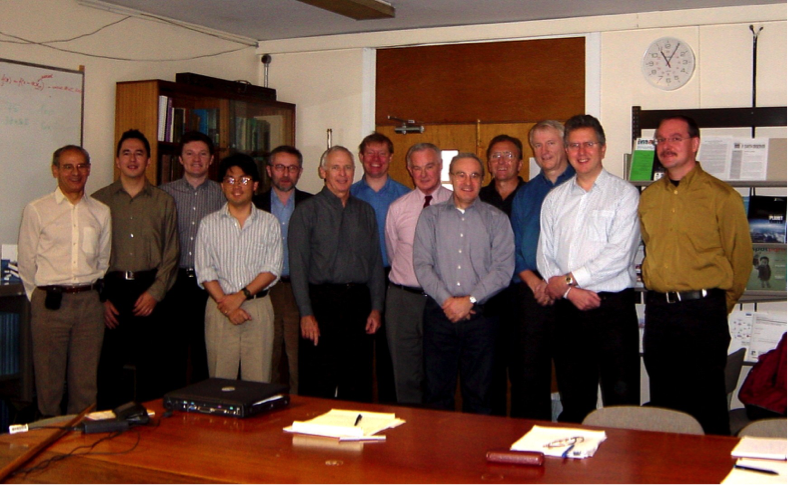
Blast from the past: a team meeting from 2002, before Rosetta even launched, which shows the original core RPC team; from left to right: Jean-Luis Michau, Chris Lee, Chris Carr, John Hanley, Karl-Heinz Glassmeier, Jim Burch, Anders Eriksson, Andre Balogh, Jean-Gabriel Trotignon, Günter Musmann, Rickard Lundin, Andrew Coates, Ingo Richter. Today’s team comprises 21 people working on the instrument operations, and 63 people in the complete science team (with some cross-over between science and operations). Image courtesy C. Carr.
Ingo also recalls the time at ESOC during Rosetta’s hibernation in June 2011, and 31 months later, in January 2014, when it woke up again…: “Just before hibernation at the Rosetta switch-off event, members of the RPC team were by chance visiting ESOC for a meeting. We had the chance to stay close to the flight control team during those exciting minutes when the switch-off commands were sent. We saw on the monitors Rosetta falling asleep… Amazing!
“At the counterpart event on 20 January 2014, I was at ESOC as well. Those endless, nerve-wracking minutes of waiting for Rosetta’s carrier-signal were a real adventure that I would not like to have missed! At the end when Rosetta was ‘alive’ again we all felt really like a big Rosetta family and a certain ‘space-spirit’ flooded the meeting room at ESOC. Unprecedented!”
There were also a highly nerve-wracking moment during the post-hibernation commissioning phase in spring 2014. Ingo says: “A critical moment for RPC was the loss of the main power supply of our plasma unit. A capacitor died and got a short circuit, causing the complete failure of our main power supply. Fortunately the plasma unit is equipped with a complete redundant power supply, which was immediately started in order to provide the power. It was working fine after ten years in space, and works well even to this day!”
Hans Nilsson also recalls a ‘dark moment’ during the post-hibernation commissioning for the RPC-ICA sensor: “The instrument suffered overheating and was automatically turned off. This was a problem that had occurred a few times during cruise phase, but we had hoped that we would see less of it during the early mission when the instrument temperature was lower. We discovered that a loss of data we had sometimes seen was due to a systematic problem in the instrument, causing loss of up to half our data. We ran the instrument for only brief periods of time, fearing that the next overheating event might kill the instrument. The overheating events appeared to get more common, and when we had two within a few days we feared that the end was near for our instrument. But the opposite happened. Suddenly the overheating events became very rare, and we could start to operate the instrument continuously. After some more time, we discovered that in an alternative operation mode, we also got rid of the data loss. Seldom has an instrument improved so much during a mission!”
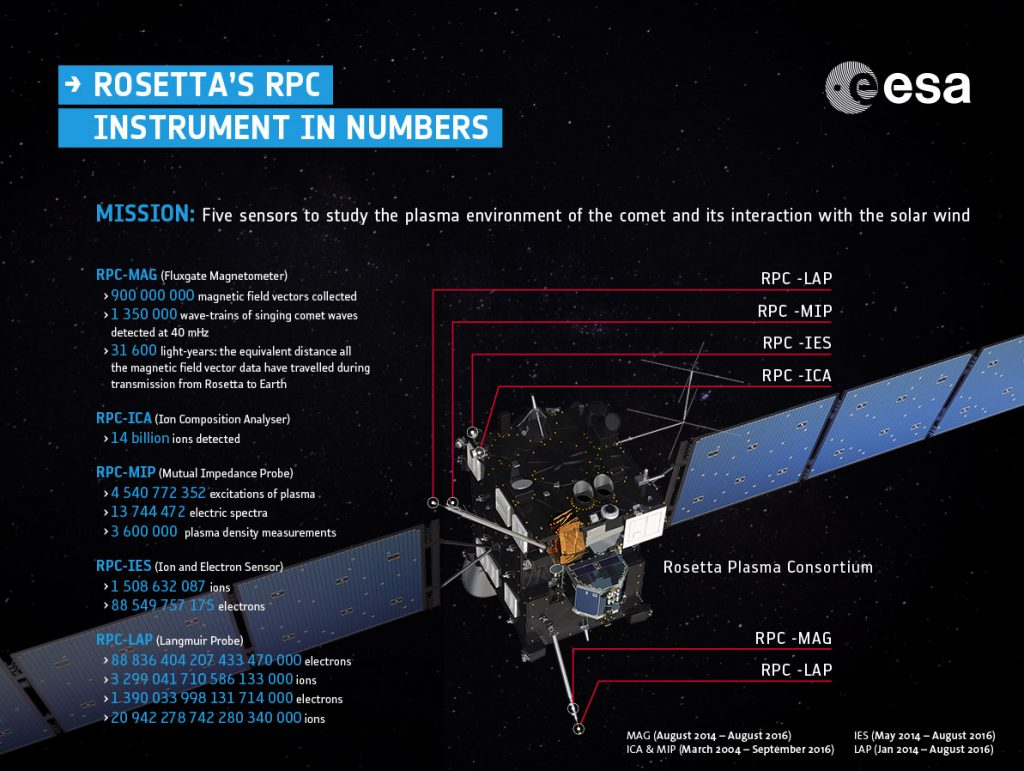
Note: LAP does not count individual particles but measures the electric current carried by them as they reach the instrument. Summing up that current gives the numbers shown above.
Fast-forward a few months to arriving at the comet. “Seeing the first cometary ions unambiguously identified in our data on 7 August, one day after official arrival at the comet, was a good start to the active mission,” says Hans. “The most exciting observation was not just one observation, but the string of new things that appeared in the period September to October 2014. It felt like every week brought something new we had never seen before.”
Then came Philae’s dramatic landing in November 2014. Measurements made between the Rosetta orbiter’s RPC-MAG instrument and Philae’s ROMAP during its descent and the flight across the surface were not only set to reveal unique properties about the comet, but also used to help piece together what happened to Philae.
“Philae’s landing led to unique joint observations of Rosetta’s RPC-MAG and Philae’s ROMAP,” says Ingo. “The very sophisticated data analysis revealed the dynamic and final attitude of Philae during descent and landing, derived from the joint magnetic field data. At the same time, the properties of the “singing comet” waves could be studied in detail using these combined datasets. It was a really surprising find: the existence of such waves was not known before. Although there was some evidence in our simulations, the data had to be interpreted in the right way – more about that will be coming soon!”
As comet activity increased as it moved closer to the Sun along its orbit, so the RPC instruments enjoyed more and more interesting data of how the comet interacted with the solar wind and plasma environment.
Hans says: As comet activity increased the comet water ions responded in a different manner to the solar wind. The most surprising result from RPC-ICA was how large the deflection of the solar wind could be. When the comet water ions are added to the solar wind, the water ions are accelerated in the direction of the solar wind electric field. Due to conservation of momentum, the solar wind is deflected in the opposite direction (a bit like billiard balls). When the deflection reached 90° we thought that would be the maximum. But the solar wind ions kept being deflected, reaching 180°, i.e. moving back towards the Sun.
For Christopher Carr one of the most remarkable measurements was the detection of the record-breaking 280nT magnetic field, made on 3 July 2015. “As far as we know this is the highest magnetic field directly measured by a mission in interplanetary space. It is especially remarkable given that the background magnetic field carried by the solar wind would be only 1-2nT and that the comet itself is unmagnetised!
“The detection of the magnetic cavity – a flat zero-field without any magnetic field variations – was also a big event,” adds Ingo. “It was seen already at comet Halley and therefore somehow expected, but when it really happened in summer 2015 we all were very excited and happy. The surprising thing about it was that it occurred much closer to the comet nucleus than we were expecting from what we saw at Halley. Research on this is still going on and more scientific papers will be published soon.”
Hans adds: “The nightside excursion was another moment of excitement. We hoped it would show us how the ions of the comet tail were initially accelerated to later form a structured ion tail. We got very good measurements, showing the gradual acceleration of the ions with distance. This is a data set we are really looking forward to examining in more detail.”
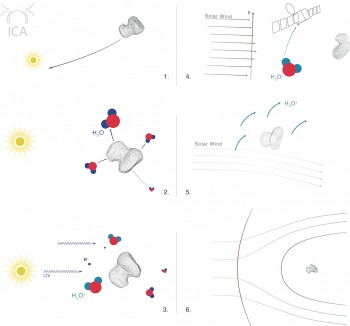
How a comet grows a magnetosphere
1. The comet approaches the Sun
2. Water molecules sublimate from the comet as it thaws
3. The water molecules are ionised by ultraviolet light from the Sun
4. Newborn ions are accelerated by the solar wind electric field and are detected by the RPC-ICA instrument
5. The solar wind accelerates the water ions in one direction, but is itself deflected in the opposite direction
Credits: ESA/Rosetta/RPC-ICA
Hans also notes that thanks to Rosetta’s unique position flying alongside a comet for two years, they could watch the ‘birth’ of the comet magnetosphere. “We’re used to looking at data from spacecraft flying over different regions of space around planets. With the Rosetta mission, we rather saw the comet magnetosphere form and expand around the spacecraft over a two-year time period. Rosetta was located in different parts of the comet magnetosphere not because of its own motion, but because the magnetosphere changed in size and shape. In May-June 2015 we said goodbye to the solar wind ions. Rosetta was now inside the comet magnetosphere, where it remained until December 2015.”
Anders Eriksson notes that as a result of the ever-changing comet environment, his team has had to change the settings of the RPC-LAP instrument a number of times to keep up: “We’ve uploaded new “apps” (macros, small programs running again and again to perform some cycle of measurements) 10 times, which is also the approximate number of times we have driven the operations manager of RPC, Emanuele Cupido at Imperial College, and our contact at ESOC, José-Luis Pellon-Bailon, mad by coming up with new and strange requests,” he jokes.
On the overall data collection of the RPC instruments, Chris comments: “The plasma environment has been quite hard to understand and it’s taken us a bit of time to get on top of what’s going on at the comet. But at a team meeting earlier this year, when we were looking at the data from one of the far excursions away from the comet nucleus and, putting all the data together from all of our five sensor at the same time, we finally began to get an understanding of how the solar wind interaction with a weakly outgassing comet ‘works’.”
And on Rosetta’s final descent to the surface, Chris concludes: “We’re really looking forward to the final hours of data collection, when the RPC sensors will all be on until the final seconds. We’re hoping to make measurements of how the solar wind impacts directly onto the surface, for example we hope to measure charged dust grains levitated from the surface by electrostatic forces.”
This post is part of a series that looks behind the scenes of the instrument teams to find out what it was really like “living with a comet” for two years.
Blog posts featuring RPC
Rosetta finds magnetic field-free bubble at comet
What made the comet sing?
Comet’s firework display ahead of perihelion
First release of Rosetta comet phase data from four orbiter instruments
Rosetta shows how comet interacts with the solar wind
Watching the birth of a comet magnetosphere
Getting to know Rosetta’s comet – Science special edition
The singing comet
Rosetta’s plasma experiments check out of commissioning

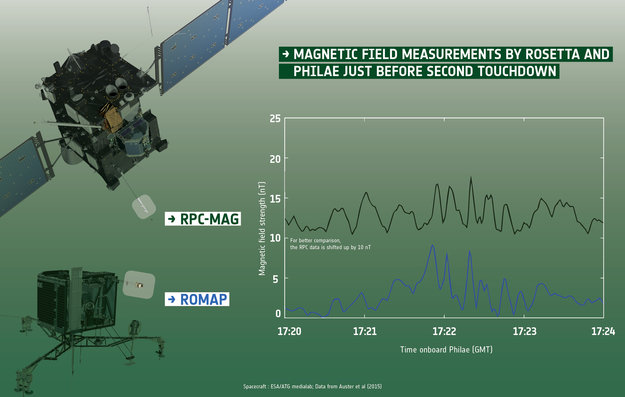
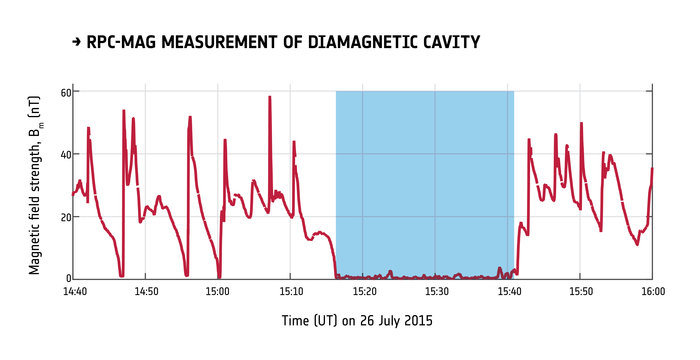








Discussion: 3 comments
Very intriguing article, the struggle to keep up with the changes on the comet and the reliability issues with the instrument. Also the high magnetic field and the 180 degree deflection of the solar wind, the acceleration of the ions to form a structured tail during the night-side excursion, also the discovery of the magnetic cavity and its closeness to the comet.
Sounds like an exiting ride, I look forward to more information, and thanks for sharing what you have so far.
regards
Great stuff. I never thought I could get too excited about plasma data – but this mission has changed that!
Regarding Hans comments about the diamagnetic cavity –
“The surprising thing about it was that it occurred much closer to the comet nucleus than we were expecting from what we saw at Halley.”
I think maybe he meant “much further” from the nucleus than expected. I think originally it had been thought that it would be too close for the team to sample it, particularly given the distances that the s/c had to orbit at during perihelion.
Still looking forward to the results from the tail excursion.
^^^Whoops! The comment about the diamagnetic cavity was by Ingo Richter, not Hans Nilsson.